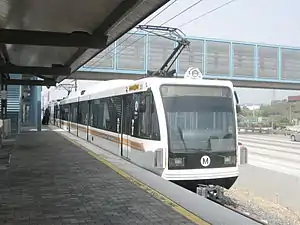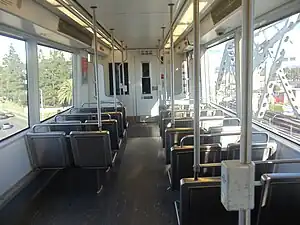| Siemens P2000 | |
|---|---|
 | |
 | |
| In service | 2000–present |
| Manufacturer | Siemens Mobility |
| Constructed | 1996–1999 |
| Entered service | 2000–2003 |
| Refurbished | Alstom 2019—2024 |
| Number built | 52 |
| Formation | Single unit |
| Fleet numbers | 201–250, 301–302 |
| Capacity | 100 (76 seats) |
| Operators | |
| Depots | Division 11 (Long Beach) Division 22 (Hawthorne) |
| Lines served | |
| Specifications | |
| Car body construction | LAHT |
| Train length | 268 ft 8 in (81.9 m) (three cars) |
| Car length | 89 ft 7 in (27.3 m) |
| Width | 8 ft 8 in (2.65 m) |
| Height | 12 ft 4 in (3.76 m) (without pantograph) |
| Floor height | 3 ft 2.4 in (975 mm) |
| Doors | 8 (4 per side) |
| Articulated sections | 2 (one articulation) |
| Wheelbase | 6 ft 11 in (2.1 m) |
| Maximum speed | 70 mph (110 km/h) |
| Weight | 98,000 lb (44 t) |
| Traction system |
|
| Traction motors | 4 × 185 hp (138 kW) |
| Power output | 740 hp (552 kW) |
| Acceleration | 3 mph/s (4.4 ft/s2; 1.3 m/s2) |
| Deceleration | 3.5 mph/s (5.1 ft/s2; 1.6 m/s2) |
| Electric system(s) | 750 V DC overhead catenary |
| Current collector(s) | Brecknell Willis & Faiveley pantographs |
| UIC classification | Bo′+2′+Bo′ |
| AAR wheel arrangement | B-2-B |
| Safety system(s) | ATC, Emergency brakes, ATP, ATO |
| Coupling system | Tomlinson |
| Track gauge | 4 ft 8+1⁄2 in (1,435 mm) standard gauge |
| Notes/references | |
| [2] | |
The P2000 is an articulated light rail car used on the Los Angeles Metro Rail system. It was manufactured by Siemens Mobility and is used on the C Line. It was also used on the L Line between 2003 and 2012 and the A and E lines thereafter. However, it returned in revenue service on the L Line in 2023 shortly before the Regional Connector began revenue service and the L Line was discontinued. It has since been removed for refurbishment with follow-up testing. As of 2023, some P2000s have returned to service on the C Line and are currently being tested on the A Line.
The trains feature automatic train control, automatic train operation for C Line service, air conditioning, emergency intercoms, wheelchair spaces and emergency braking.
In June 2013, Metro awarded a fixed price contract to PAMCO Machine Works in Monrovia, California, to overhaul the powered axle assemblies for the then thirteen year old P2000's.[3][4]
Since 2020, some units have been taken out of service for refurbishment by Alstom.[5]
See also
Other Los Angeles Metro light rail vehicles:
Other Siemens light rail vehicles for the American market:
- Siemens–Duewag U2 – high-floor LRV for either level boarding at high-platform stations or steps for passenger loading at street level
- SD-100 and SD-160 – high-floor LRV for either level boarding at high-platform stations or steps for passenger loading at street level
- SD-400 and SD-460 – high-floor LRV for both level boarding at high-platform stations and with steps for passenger loading at street level
- SD660 – low-floor LRV for passenger loading at street level, custom built for Portland, Oregon
- S700 and S70 – low-floor LRV for passenger loading at street level
- S200 – high-floor LRV for level boarding at high-platform stations
References
- ↑ "RCC board recommendation: Vehicle Acquisition Project - Contract No. P2000 - Los Angeles Standard Light Rail Vehicle - Recommendation for Award" (PDF). Archived from the original (PDF) on September 27, 2023. Retrieved October 21, 2023.
- ↑ "Los Angeles P2000 Light Rail Vehicle" (PDF). Siemens Mobility. Siemens AG. Archived from the original (PDF) on June 24, 2016. Retrieved March 7, 2016.
- ↑ "P2000 Light Rail Vehicle Powered Axle Assembly Overhaul" (PDF). media.metro.net. LACMTA. Archived (PDF) from the original on 9 March 2016. Retrieved 8 March 2016.
- ↑ "Siemens P2000 Light Rail Vehicle – Technical Information" (PDF). Siemens Transportation Systems. 2005. Archived from the original (PDF) on August 9, 2007.
- ↑ Chen, Anna (2020-10-06). "Metro receives first modernized P2000 light rail vehicle". The Source. Archived from the original on 2022-05-16. Retrieved 2022-03-13.
External links
 Media related to Siemens P2000 at Wikimedia Commons
Media related to Siemens P2000 at Wikimedia Commons